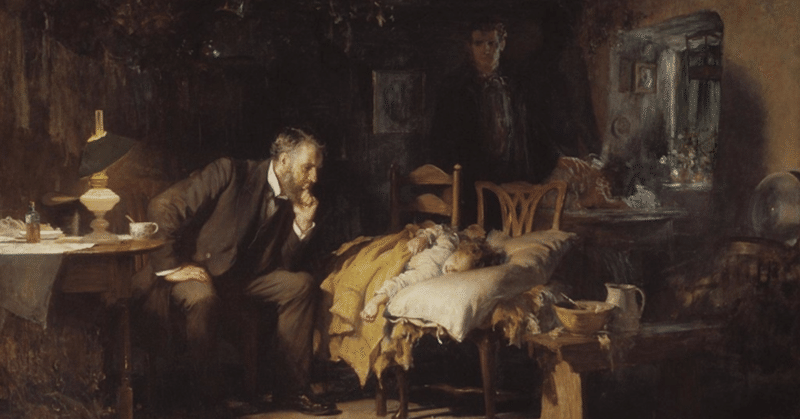
#12 Get the heart of art in your science eyes
from
September 13, 2021, Weekly Medical Journal (Residential Edition):
No. 3436
Looking back on human history, it seems that until recently, it was common to sense "invisible entities" such as ayakashi (myths) and kami (gods) in the background of natural phenomena and everyday life. However, with the advent of the "eye of science" and the progress in elucidating phenomena and the access to all kinds of knowledge via the Internet, "invisible beings" have been relegated to the fringes of the world.
Nevertheless, the sanctuary that will remain difficult to elucidate until the end of time is the human mind. It constantly changes with time and circumstances and cannot be easily observed or evaluated.
Cultivating Sensitivity to Perceive and Insight into the Unseen
Let's take a look at this masterpiece by Luke Fils. In the center, the foregrounds are a child lying in bed and a male doctor sitting in a chair watching him. It was painted more than 100 years ago as a great tribute to the doctor who provided bedside vigilance to Fils' son, who died on Christmas Eve. It can be said that this physician remained sincerely devoted to his patients.

What about modern medicine? We spend more and more time looking at patients through monitors that display data from tests, etc. This has dramatically reduced the face-to-face opportunities to feel the weight of a patient's words and gaze.
If these opportunities are lost, the sensibility to perceive and gain insight into the unseen will inevitably decline. Therefore, the most important point I wanted to convey through this series of articles was to review one's sensitivity and apply it to one's medical practice by taking the opportunity to appreciate masterpieces.
Importance of Science and Art in Medicine
In medicine, the importance of science and art is often mentioned. In medicine, science refers to the vast amount of knowledge and skills that have been accumulated to diagnose and treat diseases accurately. We, as medical practitioners, have been studying to reach a higher level while riding on the shoulders of giants so as not to neglect the wisdom accumulated by our predecessors.
On the other hand, aspects of patients cannot be captured by science alone. The more we face them head-on, the more we realize that no two people are the same and that we can never recognize them only through numbers and data. It is an art that senses the "invisible presence," such as the subtleties of a patient's mind and thoughts. To cultivate an artistic mind, I think it is essential to be aware of the kind of practice one wants to pursue and nurture the buds of sensitivity and aesthetics that one finds "good" with care, little by little and without haste.
What is born when we confront a silent masterpiece?
I teach a class of the same name as this series at a university. One of the students who completed the course wrote in a questionnaire, "I realized that my father, who used to sleep at home on weekends, actually got up earlier than anyone else to weed the house. As the resolution of the world we perceive increases, we have more opportunities to notice and feel things that we have missed before. Being aware is far more important than knowledge or being taught. Is it a naive dream to believe that the more we become aware of the richness of clinical practice, the more we will naturally change medicine for the better? I believe not.
In this series of 12 articles, I have looked at and considered famous paintings from various angles. The "key" to nurturing the heart of art is hidden in the white coat, in what is created when we confront the unspeakable masterpieces.
Masterpiece: The Doctor (Luke Fils), Public Domain
まだまだコンテンツも未熟ですが応援して頂けるとすっごい励みになります!
